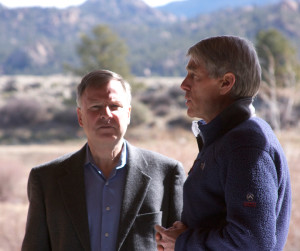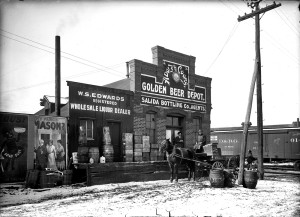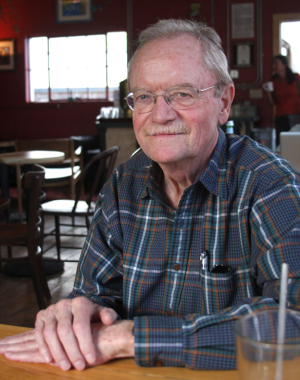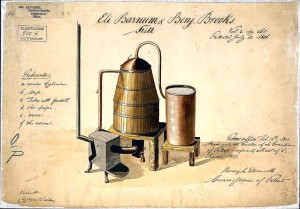By George Sibley
Clear blue sky, air perfectly still – it’s one of those true Colorado days as I sit down to work this morning. One of those Colorado days that makes it hard to sit down to work.
I’ve been fiddling around at the screen for the past couple days, thinking about all the serious things I ought to be trying to work out in words, if only for myself – the potentially endangered Gunnison Grouse, capitalism and the problem of the commons, drought and climate change, et cetera. But it is hard on such a day to sit down to such work. You want to get up to work, or play, or something that combines both; something that requires you to “leap, burst forth, fly up,” springan in the Old English – the ancient utterance (undoubtedly first uttered on a day like this) that gave us one of our most dynamic noun-verb words, spring.
Yep, it’s springtime in the Rockies – although anyone who has been here more than a couple of years knows that “springtime in the Rockies” is a season that needs to be parsed. If the Inuit people have dozens of words for different kinds of snow, we should have some similar distinctions for the different manifestations of springtime in the Rockies. So I may as well eschew responsibility today and just write about the different seasons of spring in the Southern Rockies.
This morning exemplifies what I would call “High Spring” – the equinoctial time, usually in March, when the subtropical high pressure ridge reaches all the way up through Utah and Colorado, sometimes for a week or two weeks of clear, still weather, and the sun again begins to focus on the northern hemisphere. You imagine you can actually feel those streams of photons arriving from the sun and slamming into the planet at 670 million miles per hour. Some of them doing crazy billiard stunts up in the atmosphere, bouncing off of dust and vapor particles in the mystery that creates the inimitable blue of the sky. Some of them hitting what remains of the earth’s snow cover at enough of an angle to go bouncing back unchanged into space. But the rest crashing to earth at ground zero, converting immediately into longwave infrared heat energy that goes to work on the still potent presence of winter.
We still have some snow in Gunnison (and will undoubtedly get more), but it is now losing the battle against those incoming shortwave photon streams. In the March mornings, the snow develops a frozen crust that you can walk on without breaking through, but by midday that is soft and soggy with snowmelt. As the snowpack on the sunny side of the mountains starts to melt, heat for the melting (80 calories per gram) is sucked out of the air, creating downhill “chinook” flows that become local breezes, sometimes real winds, in the valleys below – “The wind won’t stop,” oldtimers say, “till the snow is off the peaks.”
As March passes into April, the long episodes of “High Spring” get increasingly interrupted by episodes of “Low Spring” – a less enthralling season when the weather turns to a mostly miserable, often intense reprise of winter at its most dour, made worse by unrealistic hopes that winter might be gone for the year. The snow cover is usually gone from Gunnison by early April, but up-valley, Crested Butte looks like the snout of a really dirty glacier. As snow melts, it exposes and concentrates whatever blown-in dust, soot, dog deposits, two-o’clock barfs, et cetera that have accumulated and been buried by subsequent snows over the course of the winter, and where there is not snow there is mud. Everyone up-valley who can afford to leave for someplace warmer and drier in April and May – even if it’s only Montrose or Salida – does so.
Through April and into May, Low Spring dominates High Spring, and any morning during that time when you wake up to a clear sky and warm sun – you know, you know that by midday it is probably going to cloud up and the temperature is going to drop 20 degrees and it is going to snow a miserable inch of snow, accompanied by wind, melt it off, then snow another inch, and so on into the miserable evening. You know this, in that brilliant morning, but, business permitting, you still get out the hiking or fishing gear and head out – and get caught out again.
Usually the “Low Spring” storms are fast and vicious, cold furious windy snows that contribute more discomfort to living beings than water for the runoff, but there are exceptions. One year in the 1990s – I forget which one – 30 inches of wet soggy snow fell overnight in the Upper Gunnison during the last week of May. Late spring storms in 1983 almost took out Glen Canyon Dam.
Up in the high country where the snow is deep (not a problem this year, unfortunately), the trickle of melting snow down into the snowpack – no longer white due to the concentrating of windblown dust from the southwest’s growing deserts – begins to “rot” the entire snowpack. When my family and I were working (such as it was) as winter caretakers for the Rocky Mountain Biological Laboratory – “ski in, ski out” to Crested Butte, five miles – I was pulling my young son home from town on the toboggan one April day when I suddenly crashed through the snowpack right down to the ground, and into a stream flowing about ankle deep in snowmelt water that had hollowed out the bottom of the snowpack. My son thought it was hilarious, what Dad was doing; but meanwhile all the heavy soggy snow around me had collapsed in on top of my skis, more or less trapping me in that cold stream, and I experienced a moment or two of mild panic. But fairly quickly, that snow too turned to water, and I could slosh and sidestep my way back up onto less terminally rotten snow. I had the feeling that the entire snowpack in the sunny part of the valley was trembling on the cusp of the transformation from solid to liquid.
“April is the cruelest month,” said T.S. Eliot – but up in the mountains it isn’t teasing with lilacs bred out of the seemingly dead land, at least not in the depths of “Low Spring.” But there does come a day – and that day is coming earlier every year, it seems – when one of those nasty little storms blows itself out, and the sun comes out, and you realize there’s as much bare ground as snow-covered ground, and it is actually starting to show some green. It’s the time of year when up at Biological Lab we might see a hare still in his winter white, sitting on a south-facing patch of bare ground, trying desperately to remember whether his color was disguising him or displaying him.
This is the beginning of the third type of springtime in the Rockies – call it “Life Spring,” when things begin to spring back to life. In Gunnison, the little flower plot on the south side of the library suddenly has crocuses and daffodils (if they don’t get clipped by the deer still wandering around the town like large mice). It is more dramatic up-valley: right at the receding edges of the snowpack, glacier lilies bloom where yesterday, you could swear, there was still snow. And water is everywhere at that interface, sheeting off the land if it slopes, or standing in puddles and small lakes at the edge of the snow. And the great stands of aspen take on a faint reddish blush as buds swell; then the lightest, most tenuous green imaginable begins to float like smoke through the gray trees. There is nothing quite so green as a new aspen leaf.
Then there comes a “Life Spring” day when you realize the last three or four days have been brilliantly clear again; the Pacific high has again settled over the Southern Rockies, and that usually lasts through most of the month of June, the driest month. Very little water falls from the sky, but the streams and rivers are booming with it in a normal to fat year, and sometimes Tomichi Creek, at the base of Monarch Pass, just spreads out in May or early June to turn the whole broad floodplain into what looks like a vast rice paddy.
When does springtime in the Rockies end? Remarkably close to the summer solstice, if you take as its end point the last killer frost, which usually comes mid-June, plus or minus. Since everyone has their garden in by late May, weather forecasts get watched very closely till then; garden blankets get draped frequently. And after that last frost – well, as they say up in Crested Butte, “Hope summer comes on a weekend …”
And that’s springtime in the Rockies – High Spring, Low Spring, and Life Spring. Or that’s what it has been anyway. It’s shifting around now; over the forty years I’ve been around the Upper Gunnison, even the scientists agree that spring is beginning to crowd into winter – snowmelt and runoff coming measurably earlier. We’ll contemplate these changes more seriously in the future, but for today – what the hell – let’s just celebrate it, whenever it comes.
George Sibley came to the Upper Gunnison forty-some years ago for the winters, but stays for the summers.




